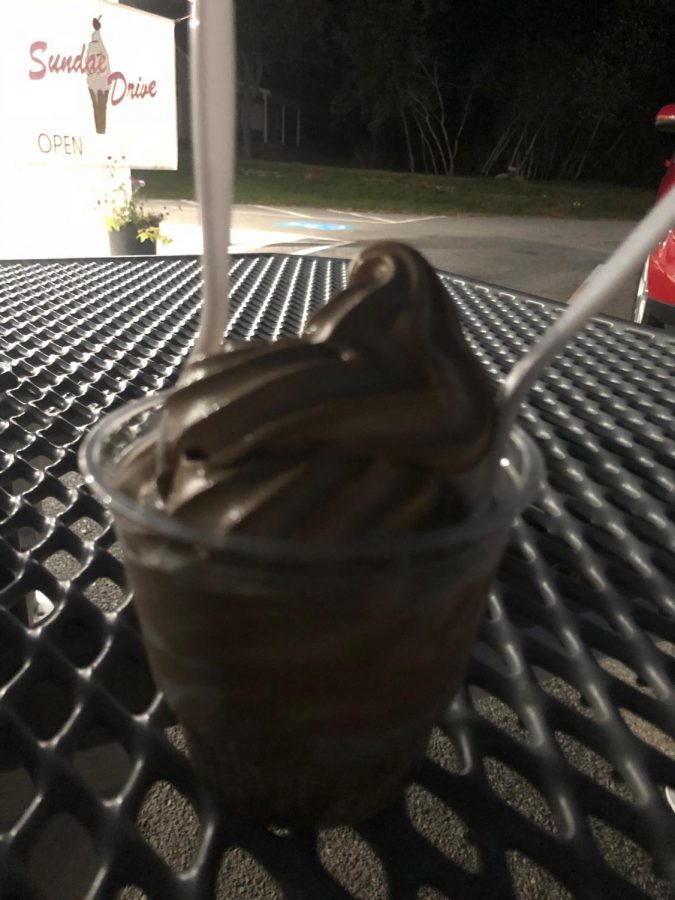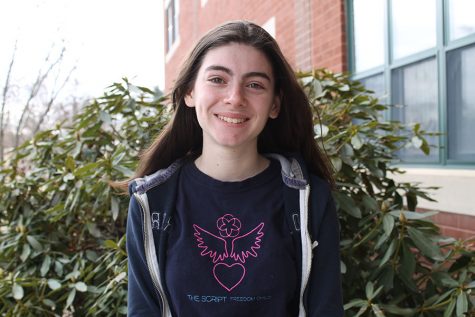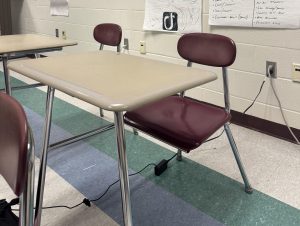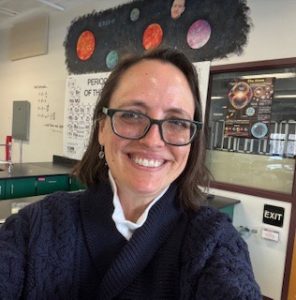There’s a world out there, and it’s time to care
Many of the objects used in everyday life are made from plastic including: toothbrushes, bottles and bottle caps, toys and so much more. In order to help control plastic’s effects on the world, we as a community have to reduce our plastic usage. “[The negatives of plastics are] so hard to get across to students, but it has to do with the mindset. If we can get people in the mindset that climate change is real… [it] will have large impact on everything around us,” said Amira Elfadil ‘19.
November 2, 2018
Plastic cups, plastic wrap, plastic chairs, plastic bears, plastic blocks, plastic clocks; plastic here, plastic there, plastic everywhere! In modern society, one of the most popular manufacturing materials, plastic (a synthetic polymer) is killing the environment one habitat at a time. Of course, plastic is still an integral piece of life and economic development, but, in order to save the one and only Planet Earth, the world has to start looking to other sources as an alternative.
Current Plastic Use and Associated Issues
In April of 2018, the Intergovernmental Panel on Climate Change published a grim report detailing the fate of humanity should the temperature of the atmosphere rise even 1.5 degrees celsius. The report, which included research from over 90 scientists from around the world, suggested that the increase in atmospheric temperature is mainly due to carbon dioxide emissions. The consequences of this potential increase include smog, flooding, economic depression and unknown health issues.
Unsurprisingly, plastic significantly contributes to the carbon footprint of the human race. “The manufacture of one pound of PET (polyethylene terephthalate) plastic can produce up to three pounds of carbon dioxide…Estimates show that one 500-milliliter (0.53 quarts) plastic bottle of water has a total carbon footprint equal to 82.8 grams (about 3 ounces) of carbon dioxide,” wrote author Marie-Luise Blue, PhD, for Sciencing. Only one plastic water bottle produces three ounces of carbon dioxide. Now, that may not seem particularly alarming, but imagine how many plastic water bottles the world uses everyday.
To put that in perspective, according to the PET Resin Association (PETRA), the United States of America alone produces 3.1 million tons of PET plastic every single year. That’s 6.2 billion pounds of plastic and approximately 18.6 billion pounds of carbon dioxide released into the environment yearly by a single country.
Yet the carbon emissions from plastic production just scratch the surface of the problems with plastic. “One, plastics are manufactured from petroleum so in using them we have to harvest that petroleum so there’s drilling in order to get that petroleum that has certain environmental impacts. And then the manufacturing of anything, but also plastics, requires a lot of water. That’s certainly an environmental issue as well, getting water for the manufacturing process. And then those plastics generally have life to them, so there’s environmental impacts in terms of how those plastics reach their end goal,” said Rodney Clark, former AP Environmental and current Biology teacher. Plastic clearly plays an integral role in many issues including the following: water usage/shortages, water pollution, habitat pollution, air pollution, and human and wildlife health.
From its creation to its life in a landfill, plastic has various negative environmental impacts, but the formation of plastic itself is quite the environmental apocalypse. “More than 99% of plastics are produced from chemicals derived from oil, natural gas and coal — all of which are dirty, non-renewable resources. If current trends continue, by 2050 the plastic industry could account for 20% of the world’s total oil consumption,” said the United Nations Environment Committee in an article for Earth Day 2018.
Fossil fuels and nonrenewable energies are detrimental in every way, shape and form. There is a limited supply, and it’s already used to power the billions of cars in the road, the stoves of many households, electricity, and so much more. Yet, manufacturers and other organizations continue to increase its use in order to meet the demand of the consumer base. A base which, according to the UN, is continuing to consume an exponentially increasing amount of single use plastic; plastic which is derived from nonrenewable energies that are responsible for the majority of climate change.
This obsession, most prominently displayed through materialism, disproportionately affects marine based life. The seabirds, dolphins, fish, whales, zooplankton, and other creatures of the deep don’t produce or use plastic, so why do they perpetually seem to pay the price? According to National Geographic’s Planet or Plastic Project, 90 percent of fledgling Flash-footed Seawaters (a large, soot colored seabird), have consumed some form of plastic thinking it was food. “Fish such as anchovies, Savoca [marine biologist with the National Oceanic and Atmospheric Administration] has found, eat plastic because it smells like food once it’s covered with algae. Seabirds, expending energy their malnourished bodies don’t have, roam farther in search of real food, only to drag back plastic waste to feed their young,” said Natasha Daly. Animals have resorted to eating plastic because they can not find anything else. Humans destroyed such animal’s habitats, humans provided them with the toxic plastic that is filling their stomachs until it makes these creatures kneel over dead. Humans are responsible for this plastic world and all the consequences that come with it.
While the manufacturing of plastics is horrible for the environment in fairly obvious ways, after its helpful life, plastic becomes even more of a detriment to global health. Since plastics never really biodegrade, where do they go? Well, according to a recent National Geographic article, plastics end up in us! Instead of biodegrading, plastic items break up into small pieces called microplastics. Those microplastics are then eaten by zooplankton, then travel up the food chain, all the way up to humans and can trigger a series of unknown health problems. “The Environmental Agency in Austria tested the stool samples for 10 different types of plastic. They found nine of them, most commonly PET and polypropylene (PP), a common component of plastic food wrappers and synthetic clothes,” said Laura Parker.
The studies on plastics in humans are still brand new; in fact, the study Parker reported on was only published in the middle of October this year. Too much plastic definitely harms the ecosystem, as can be seen by the many birds and whales found dead with plastic-filled stomachs, but scientists are still unsure of the exact health effects microplastics have on humans. “Once inside the human body, can plastic nanofibers—some five times smaller than the width of a human hair—work their way into the bloodstream, lymphatic system, or perhaps even reach a person’s liver?” said Parker.
Peer reviewed studies have proven that plastic isn’t beneficial to the general population’s health. “Plastic, one of the most preferred materials in today’s industrial world, is posing serious threat to environment and consumer’s health in many direct and indirect ways. Exposure to harmful chemicals during manufacturing, leaching in the stored food items while using plastic packages or chewing of plastic teethers and toys by children are linked with severe adverse health outcomes such as cancers, birth defects, impaired immunity, endocrine disruption, developmental and reproductive effects,” said researchers Neeti Rustagi, S.K. Pradhan, and Ritesh Singh in a study about the public health impact of plastics published by the Indian Journal of Occupational and Environmental Medicine.
The researchers go as far as suggesting that the “[p]romotion of plastics substitutes and safe disposal of plastic waste requires urgent and definitive action to take care of this potential health hazard in future.” Science clearly suggests that plastics aren’t good for humans, yet the amount of plastic produced increases every year. Society is no longer focusing on the health of the people, but is instead fixated on convenience.
Plastic and Hollis-Brookline
Here at Hollis Brookline High School, the mindset and practices of both students and adults are perpetuating the lack of interest in environmental health. Yes, the high school participates is single stream recycling and uses reusable water bottles, but that is no longer enough- the school has to catch up with the times.
For example, the Hollis Brookline High School Green Group is coming to an end. After this year, Amira Elfadil ‘19 is making the executive decision to pass on Green Group’s recycling responsibilities to the National Honors Society, and disperse the rest of their work to other student organizations. She is not taking this decision lightly, but as a senior, Elfadil knows that the group won’t survive after she goes off to college as there is little- to- no student participation. The death of the Green Group is a fitting symbol of the student body’s mindset as “ambivalent at best”.
Students and parents alike have more pressure to be concerned with activities that can go on college applications, than caring for the earth around them, even if it is something they are passionate about suggested Erin White, Hollis Brookline Middle School health and greenhouse teacher. “I read so much about how a connection with the earth is important for all of us, but especially for young people. We have a giant push for technology… I felt like we needed to balance it somehow,” said White. Environmental connection is so important that reconnecting people to their environment has become a profession, rightfully dubbed ecotherapy.
That said, the lack of regard for the cleanliness of nature or the environment in general doesn’t just reflect people’s psyche. In fact, it also seems to make people more inclined to ignore recycling efforts, be oblivious to excess plastic usage, and dismiss the planet’s repercussions. Unfortunately, those exact issues are reflected in the daily function of the high school. For example, five days a week, the cafeteria still uses styrofoam trays and cups, non-recyclable plastic containers, and single use utensils and straws.
“[Styrofoam is] cost effective. I know our previous president Alli Campbell, was going to try to fundraise to basically split the difference between styrofoam trays and compostable trays,” said Elfadil. Styrofoam, or Polystyrene (EPS), is horrible for the environment. Not only does it’s light weight and high volume take up landfill space, but it also breaks apart very easily. Those fragments of styrofoam don’t just go away, instead they become yet another microplastic that finds itself into animals and humans alike. According to writer Michelle Rose Rubio, there are limited options for styrofoam recycling, but they do exist. Yet, Hollis Brookline High School continues to use these products and does not in any way, shape or form recycle them.
Meanwhile, one town over, Milford Middle School is winning prestigious recycling awards for their excellent environmental education program. In order to help do their part for the environment, MMS joined a recycling group, called Terracycle, which collects and processes hard to recycle waste into marketable products. They have collection baskets at the Wadleigh Library and at the school where people can drop off their beauty items, energy bar wrappers, all Tom’s of Maine products, Entenmann’s Little Bites packages, contact lenses, and Bear Naked product packaging. Although the program may seem fairly simple and straightforward, it is very effective. And the best part about it is that Terracycle provides these programs for free!
There are so many options that allow Hollis and Brookline to become more active in their environmental efforts, yet the communities seem uninterested or unmotivated. According to Clark, Elfadil, John Gray and White, it is a mindset issue. “There’s a lot of kids who really care about it and work hard, and then there’s a lot of kids who throw their trash wherever they want to throw it. It’s kind of an upstream battle, I think, for them… and for us too… Kids have got to get the mentality that it’s their world,” said Head Facilities Director, John Gray.
Taking on the Impossible: How You Can Make an Impact
Luckily, changing your mindset isn’t impossible; it just takes perseverance and a few reusable containers! “[The negatives of plastics are] so hard to get across to students, but it has to do with the mindset. If we can get people in the mindset that climate change is real, and if we as a school, because we go through so much paper, plastic and styrofoam, continue throwing everything away and being environmentally unfriendly [it] will have large impact on everything around us… Once people get into that mindset, they’ll start actually doing things to help,” said Elfadil.
Some basic ways to get involved include: bringing reusable shopping bags and produce bags to the store, refusing straws at restaurants, bringing your own reusable utensils, picking up plastic you see outside, recycling everything that can be recycled, carrying a reusable water bottle, reusing school supplies and telling your friends to do the same. Reducing your own plastic waste is a great first step towards change. By changing your habits, you will influence your family, friends and others around you. In other words, the ripple effect is real- start a trend and be environmentally friendly by becoming involved in the push for less plastic.
Unfortunately, you can’t make a huge difference by reducing your personal plastic usage; this is a change that has to come from the top down. That’s where government policy comes in. Individually, many states have introduced legislation that taxes single use plastic bags, completely ban them or enact in-store recycling programs. According to the National Conference on State Legislature, California is leading this trend, starting when the state imposed a statewide ban of plastic bags at large retail stores in August of 2014. Since then, 12 states have individually enacted laws that limit single-use plastic production and distribution. However, New Hampshire is not one of those twelve. Call your senators, representatives and governors to let them know that the citizens of New Hampshire are invested in the future. Use your voice to push for regulations on single use plastics.
That said, it is also important to address plastic from the source: the corporations. “Big business are where all the pollution comes from, all the waste. So it starts with the consumers, if we start demanding that they are environmentally friendly, or boycott companies that aren’t, hopefully that’ll start the turn upward into all corporations being environmentally friendly,” said Elfadil. Now more than ever, businesses are listening to consumer concerns and switching to more environmentally friendly alternatives than risk losing their customer base.
“Instead of companies boosting profits from practices that harm the environment, increasing profitability from sustainable, eco-friendly or eco-neutral processes is a win-win for businesses and environmentalists,” said Michael Hozik for the Georgetown Environmental Law Review. For example, IKEA, Walmart, Wholefoods, HP, and several other companies have created their own campaigns to increase their environmental consciousness. With that in mind, consider using your hard earned money to favor brands and companies who are committed to reducing their plastic and carbon emissions, or who are partnering with recycling groups to make their products from used materials.
While taking on the your personal plastic usage and the nation’s may seem like an impossibly daunting task, it is doable. There are simple steps you can take to reduce your personal plastic footprint and influence the plastic footprint of the Hollis Brookline community- be the good example! By committing yourself to the cause you are also committing yourself to the future of our world. Help the countless organizations and charities working to reduce the plastic produced, in the ocean and in our bodies, and do your part; reduce, reuse, recycle, contact your local government, encourage the school to become more environmentally friendly, carefully tailor your consumerism to environmentally conscious companies and stay educated on the subject!
To hold yourself accountable for your plastic use and your promise to decrease your usage, you can join the UN tag or take the National Geographic pledge!
Author’s Note:
In writing this article, I discovered that I don’t lead an environmentally friendly life. I use too many styrofoam coffee cups, plastic energy bar wrappers and plastic wrap. For this project I took photos of some the examples of single use plastic I use everyday, and the amount of pictures I took was very eye opening. Before researching all of these aspects of environmental health relating to plastic, I thought I was a pretty good example of an environmentally conscious person. Realizing I now have to reevaluate many of my spending habits, is incredibly daunting. But, I know it has to be done- I care about the sea creatures and the birds, I care about the health of the human race and I care about the future of our one and only Earth.



![Many of the objects used in everyday life are made from plastic including: toothbrushes, bottles and bottle caps, toys and so much more. In order to help control plastic’s effects on the world, we as a community have to reduce our plastic usage. “[The negatives of plastics are] so hard to get across to students, but it has to do with the mindset. If we can get people in the mindset that climate change is real… [it] will have large impact on everything around us,” said Amira Elfadil ‘19.](https://cavchronline.com/wp-content/uploads/2018/11/WEB-READY_Theres-a-world-out-there_Oped_Hannah-Riseman-900x600.jpg)











